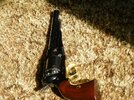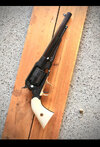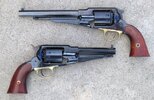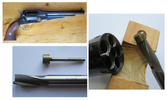You are using an out of date browser. It may not display this or other websites correctly.
You should upgrade or use an alternative browser.
You should upgrade or use an alternative browser.
broke with tradition
- Thread starter docwharden1881
- Start date
NorthBorder
Member
Hurry up and shoot it. I'd like to know what difference there is, if any, between a conversion revolver and an 1873 45 Colt. I've never
even seen a conversion revolver for sale so don't know much about them.
even seen a conversion revolver for sale so don't know much about them.
bangswitch
Member
I think the 1858 Remington is a handsome revolver. I've thought of getting the Uberti/Taylors/ Cimarron version only with the .45 Colt conversion cylinder, but haven't justified the desire yet. I have the Taylor's 1875 Remington, which is the follow-on to the 1858 and looks a lot like it, but it doesn't have the loading lever since it is designed for cartridge ammo. It still has the "sail" below the barrel. I like how it feels in the hand better than my 1873 Colt (Uberti), although the longer barrel (7-1/2") makes it a tad front heavy compared to my Colt clone (5-1/2").
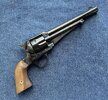

Dave DeLaurant
Member
docwharden1881
member
I have discovered that mine is shooting about 6" above the target. If I hold in the leaves I can get a decent mid-level shot. The Colt [clones] also shoot or print a little high too.
Nothing practicing or changing hold position can't cure.
Nothing practicing or changing hold position can't cure.
Driftwood Johnson
Member
I can see from the photo that his Remington has the conversion cylinder originally marketed by Taylors. This style of cylinder was designed by Ken Howell. These cylinders are chambered for 45 Colt. Even though the Cap & Ball revolvers are called '44' caliber, the rifling grooves are the correct diameter for 45 Colt. This is my old EuroArms Remington that I bought way back around 1975 or so. I bought a 45 Colt conversion cylinder for it about 20 years ago or so.Hurry up and shoot it. I'd like to know what difference there is, if any, between a conversion revolver and an 1873 45 Colt. I've never
even seen a conversion revolver for sale so don't know much about them.




Interestingly enough, six 45 Colt cartridges will not fit into one of these cylinders without the rims interfering with each other. So Howell designed the cylinders with chambers that are angled ever so slightly out at the rear, to make enough clearance for six 45 Colt rims.

Because of the lack of a bushing on the front of the cylinder, the 1858 Remington tends to quickly bind up with fouling when fired with Black Powder. Of course a the Cap & Ball cylinders should only be fired with Black Powder, but these conversion cylinders have been proofed for Smokeless "cowboy" 45 Colt ammunition.
The grip shape of the 1858 Remington is a bit different than the grip shape of a Colt. Notice there is less space between the grip and the rear of the trigger guard with the Remington than with a Colt. My experience is that full house Black Powder 45 Colt ammunition fired in the Remington will cause the trigger guard to smack my middle finger during recoil. Because of this I usually fire the Remington with Black Powder 45 Schofield ammunition. The smaller case capacity of the Schofield round means I don't stuff as much powder into them as I would in 45 Colt. I have no problem firing full house 45 Colt loads in a Colt, with the extra space between the grip and the trigger guard.

It is interesting to note that when Remington introduced their Model 1875 cartridge revolver, they lengthened the space between the grip and the trigger guard. There is even more space between grip and trigger guard on this original 1875 Remington than there is with a Colt.

Dave Markowitz
Member
Several years ago I bought a Pietta 1858 with the intention of installing a gated Kirst Konversion in .45 Colt. It turned out well.
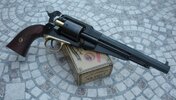
Tools used were a Dremel and files. All I've fired from it are the Black Hills cowboy loads, which are no slouch. 250 grains at ~750 FPS is more powerful than .455 Webley Mk.VI Ball and will penetrate ~12" in solid seasoned pine from ~12 yards.

Tools used were a Dremel and files. All I've fired from it are the Black Hills cowboy loads, which are no slouch. 250 grains at ~750 FPS is more powerful than .455 Webley Mk.VI Ball and will penetrate ~12" in solid seasoned pine from ~12 yards.
halfmoonclip
Member
- Joined
- Feb 4, 2011
- Messages
- 2,805
Driftwood, love the ratchets on the conversion cylinder.
Moon
Moon
unspellable
Member
The Taylor 45 Colt cylinder is proven with a standard SAAMI proof load. In the Colt and Remington reproes we are advised to stick to cowboy loads due to the soft steel in the rest of the revolver. I have mine in a Ruger Old Army which is essentially a Blackhawk, so I'm not afraid of any factory load 45. (Proof: I think here in the US, the design is proven, not each individual piece as in Europe.)
CraigC
Sixgun Nut
Says who? Cowboy loads are well under standard pressure, typically around 700fps. There is no reason to restrict your guns to those loads and no factory recommendation to do so. Howell says 850fps and Kirst says 1000fps, yet produces a .45ACP conversion safe to 23,000psi.The Taylor 45 Colt cylinder is proven with a standard SAAMI proof load. In the Colt and Remington reproes we are advised to stick to cowboy loads due to the soft steel in the rest of the revolver. I have mine in a Ruger Old Army which is essentially a Blackhawk, so I'm not afraid of any factory load 45. (Proof: I think here in the US, the design is proven, not each individual piece as in Europe.)
Hardball, lots of it.
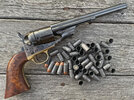
Similar threads
- Replies
- 18
- Views
- 3K


